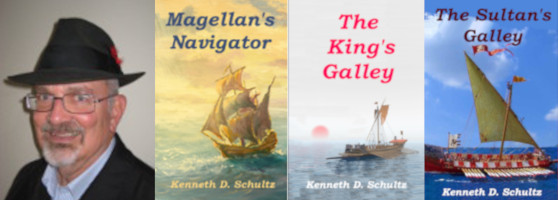Mindfield is free through Monday as an ebook on Amazon. It can be read as a military sci fi space opera with some twists, or as its title implies, it’s also about negotiating a mine field of the mind. It’s gotten a few very good reviews on Goodreads. Please get it, enjoy it, and hopefully review it.
Monthly Archives: January 2020
The King’s Galley: the Sequel to Magellan’s Navigator
We know what happened to many of the men who circumnavigated the world with Francisco Albo. Elcano ineptly piloted the next fleet to the Spice Islands, and met his fate on the Pacific Ocean. Sebastian Cabot marooned Albo’s friend Miguel de Rodas on an island off Brazil. Espinosa lived the quiet life with his family.
Oddly enough, Albo vanished from history, although there is mention of a “pilot who sailed with Magellan serving with Piri Reis.” What that Albo?
The King’s Galley, the sequel to Magellan’s Navigator, fills in the some of the blanks in this remarkable man’s life. After Albo’s meeting with King Charles, he has a falling out with the Archbishop Fonseca. The old man suspects Albo’s role in his bastard son’s death.
Albo flees Seville back to the Mediterranean of his youth, where he becomes master and pilot of one of the king’s galleys. He serves under a Spanish captain with an unwavering hatred for the Barbary pirate Barbarossa. Albo struggles to restrain the captain’s lust for revenge, which puts the entire crew and ship at risk.
Think Master and Commander on a galley in 1523. Battles are brutal. If not victorious, death is certain…either in battle, execution, or more slowly as a galley slave. But fortunes can still be made and there are women to love.
To buy follow this link: https://amzn.to/2ptXMzz
January 11, 1520 – Magellan Arrives at the Rio de la Plata
Magellan’s little armada had a pleasant two week cruise southward along the coast to recover from Rio’s bacchanals. It arrived January 11, 1520 at the Rio de la Plata, the immense estuary of the Parana and Uruguay Rivers now bounded by Argentina on the south and Uruguay on the north. This coast was well known to the Portuguese and Spanish, so he sailed by day and night. After Rio de la Plata, he would anchor each night for fear of missing the passage to the Indies in the darkness.
The Portuguese and Spanish had already explored Rio de la Plata, with the Portuguese first arriving some ten years earlier. Magellan likely had access to their finding. The Spanish came briefly in 1516 when Pilot Major of Spain Juan Diaz de Solis explored it with a small three-ship expedition. Their stay was cut short when de Solis and some of his men were killed, and eaten, by the locals. This event dampened the remaining sailors’ interest in further exploration and they returned to Spain.
So Magellan had some knowledge of the Rio de la Plata, but evidently felt that he couldn’t rule out its being the elusive pass to the Indies. He spent five precious weeks of southern hemisphere summer exploring the huge estuary, including sending his smallest ship to explore the Parana and Uruguay Rivers. That took fifteen days. Finally, his ships watered and headed south.
The time spent wasn’t without incident. They survived one gale, met the local natives without incident, repaired the leaky San Antonio, and lost two men. One of these died in a brawl. The other, the sole Irishman of the armada, one Guillen, William, drowned. Probably William, like most sailors of his time couldn’t swim.
I find it somewhat surprising that Magellan spent so long exploring the Rio de la Plata, as one would think its brackish and fresh water would rule it out as a salt-water passage to the Indies. Evidently Magellan didn’t feel any urgency to take advantage of the good summer sailing weather. Perhaps he had reason to believe the passage he sought was not much further south. It wasn’t.
The armada sailed south on February 6, 1520. Soon they’d be battered by horrific storms, all the while seeing no sign of a westward passage. Less than two months later Magellan had to admit that it was too late in the season to sail further. Ironically, Magellan wintered less than a week’s sail from the Straits of Magellan. Had he spent a few weeks less in the Rio de la Plata, he could have emerged into the Pacific Ocean months earlier, and avoided mutiny and a bitter winter in Patagonia.
Filed under Magellan, Magellan's Navigator
